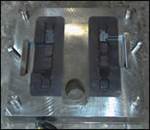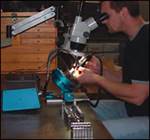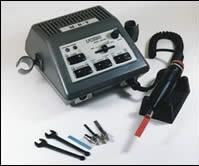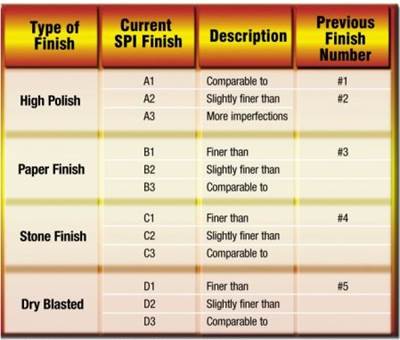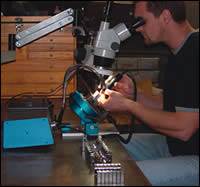When Is Ultrasonic Polishing Equipment Justified?
Ultrasonic polishing is ideal and justifiable when work on small to very small details is required.
Manual polishing is a very tedious process, and in particular very small intricate detail work requires additional effort and patience. Ultrasonic polishing machines, available now for quite some time, have been improved in recent years to effectively replace certain time-consuming and costly small detail hand finishing work.
Ultrasonic Unit Features
By comparison to conventional die profilers, as well as air-powered lapping machines that may have a stroke length of up to ¼ inch, the reciprocating action of an ultrasonic unit ranges only from .00004 to .00012 inches. However, the extremely fast reciprocating tool motion of 21,000 and up to 25,000 strokes per second provides the extra productivity and gives the polisher complete fingertip control when finishing even the most intricate ridges, slots and details.
Ultrasonic systems usually consist of an electronic power module (110 or 220 volt) with a slender electric cord that powers the lightweight and easy to manipulate small, ultrasonic handpiece. Commonly, an automatic power feed system in the module adjusts the frequency required to accommodate the various individual abrasive tools that are installed for the finishing process. The systems are equipped with numerous clamps that will accommodate tools ranging from small diamond files to conventional type polishing stones and/or ceramic stones and laps.
As with all other power tools, great care and attention should be given when working with ultrasonic machines. Because of the ultra-fast motion, tools that are overly aggressive (especially coarse diamond files, etc.) should never be used. Surfaces that must be flawless can easily be scratched and made wavy or damaged.
On the other hand, dense/hard, fine grit ceramic or vitrified abrasive polishing stones or laps made of brass and cast iron when used with premium diamond compound, permit the beginner to acquire a better understanding of the fast cutting powers these ultrasonic systems offer. Note: Only the most experienced operator should use diamond files or diamond stones for ultrasonic polishing.
Ultrasonic Applications
We need to stay objective and remind ourselves that ultrasonic polishing is not for everyone. Frequently, ultrasonic systems are perceived to take care of all polishing problems. This is not so. Ultrasonic polishing is not a cure-all for every mold and die shop that does in-house polishing. There are many polishing professionals and/or mold shops—doing mostly mid-size to large work—that may not require an ultrasonic system. In many instances, the units are simply not practical for mid-size to large type work and ultrasonic systems are not recommended to be used on larger details and surfaces exceeding a 3/8-inch square.
Nevertheless, ultrasonic finishing has its place in a polishing environment and it is not overstated to say that in some instances the cost of one ultrasonic system may be recouped by polishing three to four multiple cavity/core molds. For instance, an experienced individual, when working with an ultrasonic polishing machine on very small details, may reduce finishing time by as much as 40 percent and up to 65 percent.
In the past, there have been several good, but very expensive ultrasonic systems on the market. The name of one system may differ from the other, yet they all practically evolved from one source. However, several new models, which have been recently developed and have proved to be highly effective, as well as very affordable for even the smallest mold shop or polishing house, are now available in the marketplace.
Ultrasonic Advantages
Ultrasonic units with super fast, very short strokes, provide virtual unrestricted finger tip control. By comparison, regular reciprocating tools—such as air-driven or electric flexible shaft-operated die profilers—are more restrictive in movement and less flexible to handle.
Nevertheless, die profilers and/or various other filing machines are great for medium to large mold details and when used at a comfortable speed range and proper stroke lengths they will provide excellent finishing capabilities.
Ultrasonic polishing is ideal and justifiable when work on small to very small details is required. It is safe to say that the smaller, more intricate or precise the finishing work needs to be, and/or the harder the materials are which require finishing, the more likely it is that an ultrasonic unit will improve polishing time. Subsequently, complicated heat-treated molds and dies, carbide dies or inserts and detailed punches with fine edges and very narrow slots machined by EDM are perfect for using ultrasonic polishing systems.
It should be mentioned here that there are other advantages that make certain ultrasonic systems a practical purchase. Meaning, various models offer dual operating capabilities where the electronic power module not only has the ability to drive the ultrasonic handpiece, but also regulate the speed and rotational direction for a variety of rotary and/or reciprocating hand tools. Having these secondary functions presents additional cost savings over single function ultrasonic units as they permit a full range of filing/reciprocating capabilities as well as rotational grinding/polishing using mounted points, burs, polishing brushes and felt bobs. Furthermore, since the rotary or reciprocating hand tools are powered with internal DC motors, the thin electrical cord provides more freedom of movement when compared to flexible shaft powered tools.
Summary
When selecting a supplier for this type of equipment it is most prudent to purchase from a respectable company that has been around for many years, offers good customer service and has some experience in ultrasonic polishing, which can be passed on to the customer, even via the telephone.
Related Content
Breaking Down 3D Scanning in Moldmaking
Identifying 3D scanning requirements and implementing the appropriate technology.
Read MoreHands-on Workshop Teaches Mold Maintenance Process
Intensive workshop teaches the process of mold maintenance to help put an end to the firefighting culture of many toolrooms.
Read MoreLine Width vs. Depth Ratio in Laser Engraving
A laser does not produce 90-degree sidewalls. It requires a certain amount of draft in order to produce the required pattern.
Read MoreWhat is Scientific Maintenance? Part 2
Part two of this three-part series explains specific data that toolrooms must collect, analyze and use to truly advance to a scientific maintenance culture where you can measure real data and drive decisions.
Read MoreRead Next
Ensuring Mold Steel Polishability
When working on a project that requires high-quality texturing or surface finish, using an electro-slag quality material may be the best option for mold steel.
Read MoreHow to Increase Polishing Efficiencies
A concurrent approach to polishing increases the man-and-machine efficiency while streamlining workflow to help attain ever-decreasing leadtimes.
Read MoreTake the Guesswork Out of Mold Finishing with Micropolishing
A look at the value to the mold build process of a microscopic mold finishing process that uses ultrasonic polishing.
Read More

